by Adela Lovric // Dec. 22, 2023
This article is part of our feature topic Myth.
At Pirelli HangarBicocca’s cavernous, industrial exhibition space in Milan, Thao Nguyen Phan’s works bring a certain poetic softness. Seeping into one another through Phan’s characteristic manner of weaving narratives of the imagined and real, these videos, installations, drawings and paintings tell layered stories from the “shadows” of Vietnam and the greater Mekong region. The artist collapses timelines and evades dominant historic narratives, aiming to show truth contained in fantasy, folklore, oral histories and everyday tales, which reside in the collective consciousness and are passed down through generations. By merging historical facts with fiction, myth and fable, Phan draws attention to social and environmental issues plaguing a country ravaged by wars and exploitation.
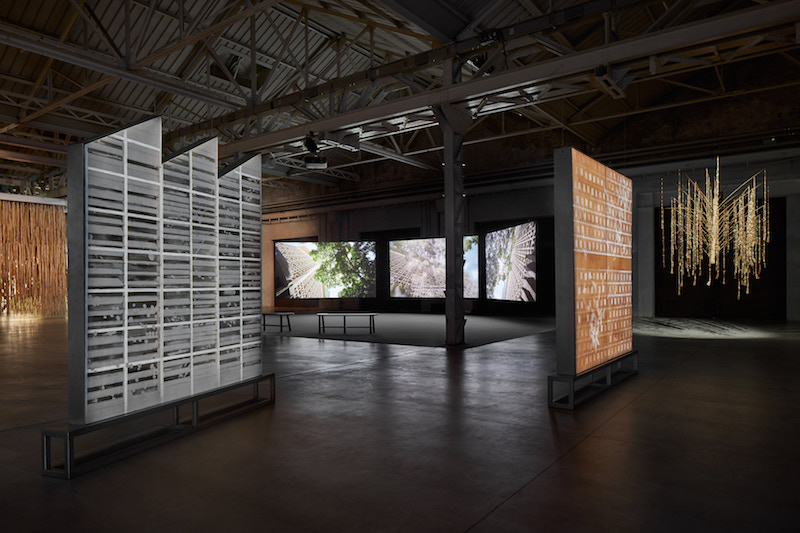
Thao Nguyen Phan: ‘Reincarnations of Shadows,’ 2023, exhibition view at Pirelli HangarBicocca, Milan // Courtesy the artist and Pirelli HangarBicocca, Milan, photo Agostino Osio
‘Reincarnations of Shadows’ is both the name of Phan’s solo show in Milan and the two-channel video commissioned by Pirelli HangarBicocca for this occasion. This “moving-image-poem”—as the artist calls it—honors the late Vietnamese modernist sculptor Diem Phung Thi, retelling her life story of exile and the fight against the French in the First Indochina War, while depicting playful tactile interactions with her works in a symbolic fashion, involving fruit, rice and soil. Phan’s fascination with the artist extends further into the exhibition space, where a selection of Thi’s collages and hand-sized, modular sculptures are displayed alongside her own artworks. While the insertion of another artist’s work can be experienced as confusing, it strengthens Phan’s concept of disregarding traditional rules and boundaries in service of a new way of looking at things. The two artists’ bodies of work coexist and elevate each other rather than compete. A sense of modesty is felt in both—in terms of scale in Thi’s and in the preference for the simple, quiet aesthetic of rural and natural life in Phan’s. These artistic choices reflect a shared concern for the actual needs and troubles of humans and their environment, opposing colonialist and other violent mechanisms causing irreparable harm. The emergence and interconnectedness of counternarratives is shown by paralleling works of these female artists across generations in postcolonial contexts as well as through the idea of reincarnation of obscured traditions and symbols through their works.
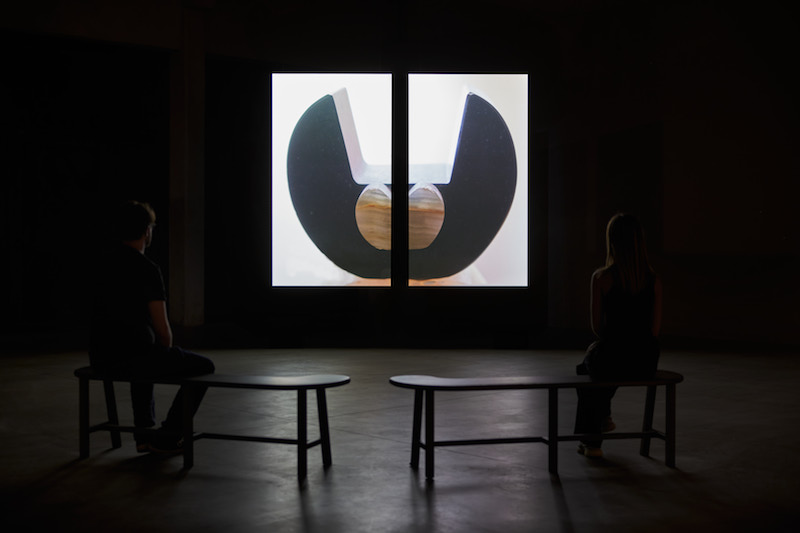
Thao Nguyen Phan: ‘Reincarnations of Shadows (moving-image-poem),’ 2023, installation view at Pirelli HangarBicocca, Milan, commissioned by Pirelli HangarBicocca and co-produced by Fondazione In Between Art Film // Courtesy the artist and Pirelli HangarBicocca, Milan, photo by Agostino Osio
While ‘Reincarnations of Shadows’ focuses on a real person whose legacy is well documented and celebrated, Phan’s three-channel video ‘First Rain, Brise Soleil’ (2021-ongoing) tells a story of a fictional construction worker who is representative of a dismissed yet essential part of Vietnamese and Cambodian architectural history. Divided in episodes, the video initially recounts the character’s memories of moving from the Mekong Delta to Saigon at the height of US financial investment in construction across Vietnam, and building concrete brise soleil, a modernist architectural element developed to protect the interiors of buildings from heat and light. Contrasting images of these structures, built around the 1960s, with those of torrential rainfall that causes floods during the monsoon season, Phan draws a connection between the production of concrete, which included sand mining from the Mekong riverbed, and the destructive environmental impact of US-aided urbanization on the life sustained by this transboundary river that stretches across East and Southeast Asia. Phan concludes this “evolving moving image” with the final episode about a myth of lost love between a Vietnamese man and a Khmer woman, in which durian, a fruit indigenous to the region, becomes a symbol of remembrance of the 1977-91 period of conflicts between Vietnam and Cambodia. Overly delineated borders—between present and past, real and mythical, political and intimate, human and natural—are forgone in Phan’s practice, giving way to new readings between seemingly disconnected occurrences.
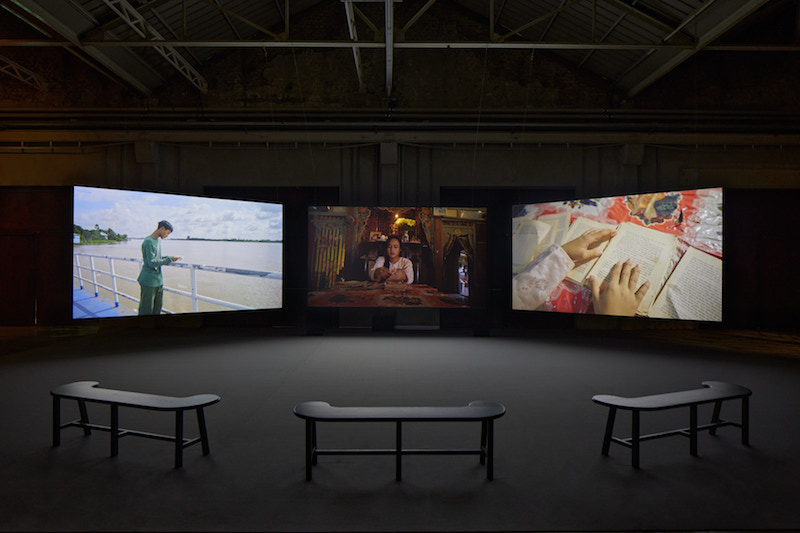
Thao Nguyen Phan: ‘First Rain, Brise Soleil,’ 2021 – ongoing, installation view at Pirelli HangarBicocca, Milan, 2023, produced by the Han Nefkens Art Foundation in collaboration with Kochi Biennale, with additional support from Tate St Ives // Courtesy the artist and Pirelli HangarBicocca, Milan, photo by Agostino Osio
Presented in dialogue with the video installation and the exhibition space, four large-scale paintings made with watercolors, graphite and acrylic on natural silk depict geometric shapes and shadow plays reminiscent of the facades of modernist buildings adorned with brise soleil. Two of these works—‘Golconde’ and ‘Hanoi’s Children Palace’ (2023)—were created specifically for this show, bringing architectural elements of Pirelli HangarBicocca’s interior into their compositions. Phan seems to nod to the venue’s industrial past as a locomotive factory and the process of industrialization that paved the way for modernity. She weaves in another modernist reference by sizing these works according to the ‘Modulor,’ Le Corbusier’s mid-20th-century anthropometric scale of proportions that was later adopted by Vietnamese and Cambodian architects.
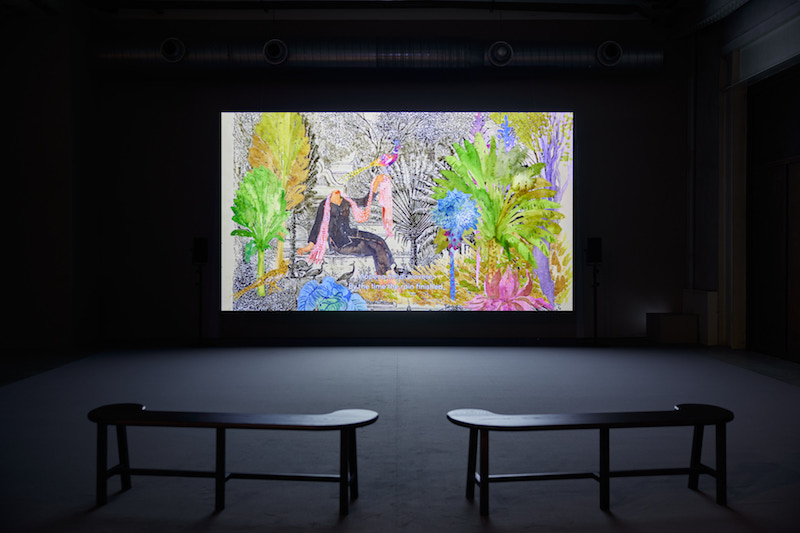
Thao Nguyen Phan: ‘Becoming Alluvium,’ 2019, installation view at Pirelli HangarBicocca, Milan, 2023, produced and commissioned by the Han Nefkens Foundation in collaboration with Fundació Joan Miró, Barcelona; WIELS Contemporary Art Centre, Brussels; Chisenhale Gallery, London // Courtesy the artist and Pirelli HangarBicocca, Milan, photo by Agostino Osio
Phan’s single-channel video ‘Becoming Alluvium’ (2019-ongoing) centers the beauty and the suffering of the Mekong River and its vast potential to give and take life, while leaning into myth as a narrative device. It tells a story of the river’s excessively exploitative transformation that caused the break of a hydroelectric dam in 2018 and delivered a death sentence to many of its residents. In the artist’s story, they remain commemorated through a “cascade of reincarnations,” in which people become animals, plants or water. Phan adds another dimension to the work by introducing hand-painted animation of a dreamlike folktale of a Khmer princess turning into river, superimposed over the images of French colonial expeditions in Mekong that set off its continued process of deterioration.
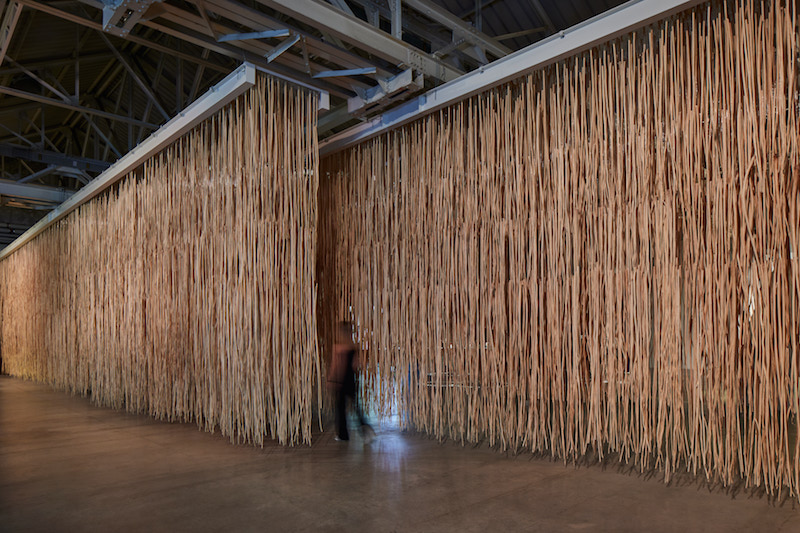
Thao Nguyen Phan: ‘No Jute Cloth for the Bones,’ 2019 – ongoing, installation view at Pirelli HangarBicocca, Milan, 2023 // Courtesy the artist and Pirelli HangarBicocca, Milan, photo by Agostino Osio
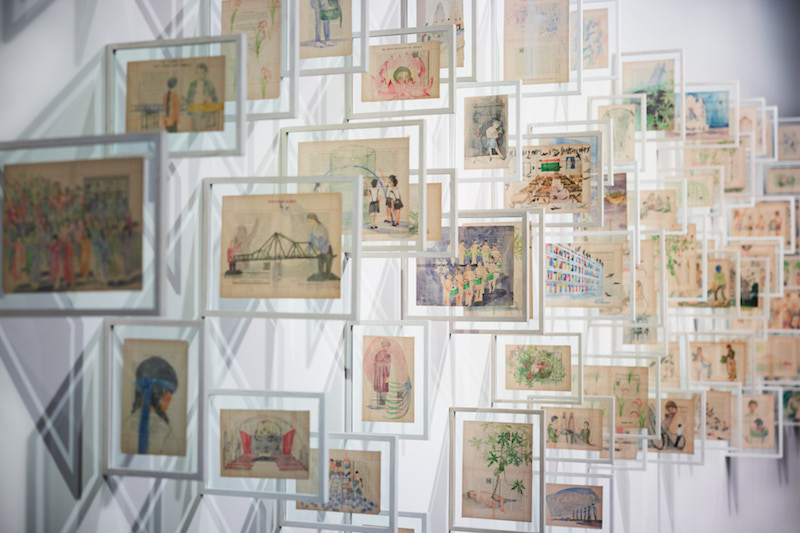
Thao Nguyen Phan: ‘Voyages de Rhodes,’ 2014-2017 (detail), installation view at Pirelli HangarBicocca, Milan, 2023 // Courtesy the artist and Pirelli HangarBicocca, Milan, photo by Agostino Osio
Applying her interest in Buddhism to her artistic practice, Phan views the medium of film as another form of reincarnation—particularly in the sense that with each new exhibition, she reshapes the works and changes the format and display. This holds true for her other artworks, as well, highlighting their open-endedness and proneness to differing processes of interpretation. In this exhibition, her installation ‘No Jute Cloth for the Bones’ (2019–23) takes a site-specific shape of two overlapping “curtains” made of suspended fibers of dried jute—a portal dividing the exhibition in two parts. It demands multi-sensory attention from the visitors as they rustle the hanging stalks to cross to the other side of the show, creating a space of emotional dissonance between discomfort and ease.
In the same vein as the installation, Phan’s three-channel video ‘Mute Grain’ (2019) brings forth the painful history of North Vietnam during the Second World War, when the Japanese occupation caused unprecedented famine, partly due to the army’s demands to uproot rice and grow jute. Phan tells this story of “the peak of human suffering” from the fictionalized perspective of two metaphorical children, March and August, named after two poorest months in the Vietnamese agricultural calendar. The recalling of events is embellished with mystical folkloric elements and paired with evocative images and sounds of rural life, of children playing and working in fields. Through many such instances, Phan brings up skewed historical narratives, only to overwrite them with her gentle reparative re-vision, aided by literary, religious and folk tales. Her poetic way of retracing collective traumas holds liberating truths that emerge when freed from the confines of the strictly guarded “official” histories.
Exhibition Info
Pirelli HangarBicocca
Thao Nguyen Phan: ‘Reincarnations of Shadows’
Exhibition: Sept. 14, 2023–Jan. 14, 2024
pirellihangarbicocca.org
Via Chiese 2, 20126 Milan, Italy, click here for map






















